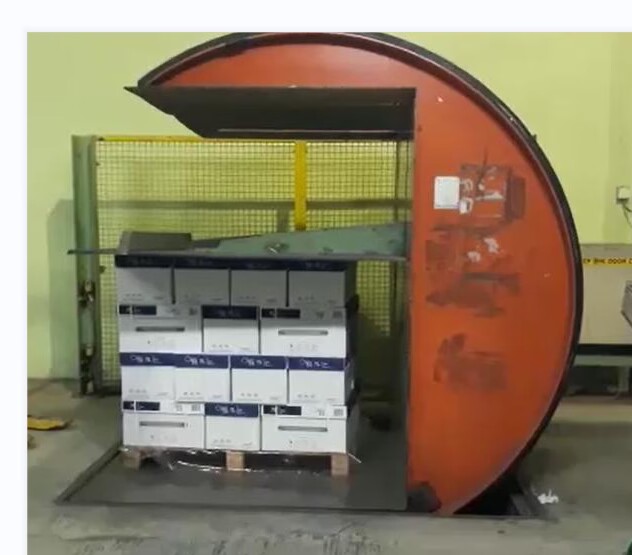Streamlining Pallet Handling: The 180-Degree C-Shape Pallet Inverter
Efficient material handling is paramount in modern logistics and manufacturing. The 180-degree pallet inverter represents a significant advancement in automated pallet manipulation, specifically designed to enhance workflow efficiency, safety, and space utilization. This technology addresses the need to invert loads for various purposes, from accessing damaged bottom layers to switching pallet types or preparing goods for specific downstream processes.
This heavy-duty C shape pallet inverter is engineered for robust performance, enabling the complete 180-degree rotation of palletized loads. It adeptly handles nested C-shape pallets ranging in length from 40 inches (approx. 1016 mm) to 120 inches (approx. 3048 mm), offering versatility across diverse industrial applications.
Operational Mechanism and Design Principles
The core function of this pallet inverter revolves around controlled rotation along a central axis. Key design elements contribute to its reliability and performance:

- Structural Integrity: Built upon a rugged, heavy-gauge steel frame, ensuring stability and durability under continuous industrial operation cycles. Finite Element Analysis (FEA) is often employed in the design phase of such equipment to optimize structural strength and predict stress points under maximum load conditions.
- Precision Guidance: High-precision linear rail guides securely support the load platform during the inversion cycle, minimizing sway and ensuring accurate positioning. This contrasts with older designs that might rely on simpler roller systems, potentially leading to higher maintenance or lower precision.
- Load Alignment: Integrated roller systems maintain proper pallet alignment throughout the rotation, preventing load shifting, tilting, or potential damage to goods.
- Drive System: The rotational force is typically generated by dual ball screw mechanisms driven by high-torque AC electric motors. Incorporating a Variable Frequency Drive (VFD) allows for precise control over motor speed, enabling smooth acceleration and deceleration. This soft start/stop capability is crucial for handling unstable loads and reducing mechanical stress on the drive train, as highlighted in numerous motion control studies (e.g., research focusing on jerk limitation in automated systems).
- Control & Automation: Programmable Logic Controllers (PLCs) often form the brain of the system, managing the rotation sequence. Adjustable limit switches or encoders allow operators to define precise start and end points for the 180-degree rotation arc, ensuring consistent operation tailored to specific pallet dimensions or load types.
Key Technical Specifications (Typical)
While specific configurations may vary, typical parameters for industrial 180-degree pallet inverters include:
- Load Capacity: 1500 kg - 2500 kg (3300 lbs - 5500 lbs)
- Rotation Angle: Full 180 degrees
- Cycle Time: 45 - 75 seconds (dependent on load and specific configuration)
- Pallet Size Compatibility: Accommodates lengths from 40" to 120" (as specified) and standard widths/heights.
- Power Requirements: 3-Phase AC power (e.g., 480V/60Hz or 380V/50Hz)
- Control Interface: Push-button controls, potentially with HMI touchscreen options.
- Construction: Powder-coated heavy-duty steel.
Industrial Applications
The 180-degree pallet inverter finds utility across a wide spectrum of industries:
- Warehousing & Distribution: Facilitating pallet exchange (e.g., wood to plastic/hygienic), order picking from bottom layers, and load consolidation.
- Manufacturing: Inverting work-in-progress materials for processing on opposite sides, or preparing finished goods for specific packaging orientations.
- Food & Beverage: Enabling access for quality checks, slip sheet insertion/removal, and transfer to sanitized pallets required in cleanroom environments. Compliance with hygiene standards (e.g., HACCP) often necessitates such transfers.
- Pharmaceuticals: Similar to food/beverage, crucial for maintaining stringent hygiene protocols and enabling batch processing or inspection.
- Printing & Paper: Turning stacks of paper or printed materials for double-sided processing or finishing.
- Pallet Rental & Pooling: Efficiently managing and inspecting pallet inventories.
Core Operational Benefits
Implementing a 180-degree pallet inverter delivers tangible advantages:
- Enhanced Throughput: Automates a previously manual or multi-step process, significantly reducing cycle times and increasing overall handling speed.
- Optimized Space Utilization: Enables more efficient stacking and storage configurations by standardizing pallet orientation or facilitating access to lower levels without extensive depalletizing.
- Improved Product Protection: Controlled, smooth rotation minimizes the risk of damage associated with manual handling or less sophisticated tilting equipment.
- Increased Workplace Safety & Ergonomics: Eliminates strenuous manual lifting and turning tasks, mitigating risks of musculoskeletal injuries, aligning with OSHA guidelines and ergonomic best practices.
- Operational Flexibility: Easily switches between different pallet types (e.g., internal vs. shipping pallets) or prepares loads for specific automated systems (like ASRS).
- Reduced Labor Costs: Frees up personnel from manual inversion tasks, allowing redeployment to higher-value activities.
Safety and Maintenance Considerations
Modern industrial equipment prioritizes safety. These inverters typically incorporate:
- Safety Guarding: Physical barriers or light curtains to prevent personnel access during operation.
- Interlock Systems: Ensuring doors or gates must be closed for the machine to operate.
- Emergency Stop Buttons: Strategically placed for immediate cycle interruption.
- Maintenance: Designed for reliability, components like grease-sealed bearings and robust chain/screw drives minimize friction and wear. Routine inspections and preventative maintenance schedules are crucial for longevity, often outlined in manufacturer guidelines based on operational cycles.
Conclusion
The 180-degree C-shape pallet inverter is a specialized yet versatile piece of industrial automation equipment that addresses critical needs in material handling. By providing fast, safe, and controlled full inversion of palletized loads, it streamlines logistics, reduces operational costs, enhances worker safety, and boosts overall productivity. Its robust construction, precision engineering, and adaptability make it an invaluable asset for facilities requiring efficient handling and orientation control of diverse pallet loads, from distribution centers and manufacturing plants to specialized industries like food processing and pharmaceuticals. This technology represents a smart investment towards optimizing complex supply chain operations.

